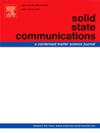自旋轨道耦合对二维应变铅苯单层的影响
IF 2.1
4区 物理与天体物理
Q3 PHYSICS, CONDENSED MATTER
引用次数: 0
摘要
利用密度泛函理论研究了自旋轨道耦合(SOC)对原始铅烯和应变铅烯的影响。在双轴应变作用下,未应变铅烯和应变铅烯均表现出金属行为。在SOC条件下,在非应变铅烯中观察到0.47 eV的间接带隙开度。在SOC的作用下,当施加0 % ~ 10%的压缩应变时,带隙从0.47 eV减小到0 eV,表明系统从半导体转变为金属。然而,当SOC施加高达10%的拉伸应变时,带隙从0.47 eV变化到0.66 eV,带隙排列从间接转变为直接转变。结果表明,在外加应变的作用下,电子和空穴的有效质量发生了变化。原始单层铅烯的有效电子质量为0.0195m0,有效空穴质量为0.0237m0。为了检查原始和应变结构的稳定性,我们进行了声子计算。我们的发现表明,在拉伸应变(高达10%)下,结构是稳定的。该研究为实现单层铅烯的应变调节提供了理论依据。本文章由计算机程序翻译,如有差异,请以英文原文为准。
Influence of spin-orbit coupling on 2D strained plumbene monolayer
We have investigated the effect of spin-orbit coupling (SOC) on pristine and strained plumbene using density functional theory. Without SOC but under the application of biaxial strain, both unstrained and strained plumbene show metallic behaviour. With SOC, an indirect band gap opening of 0.47 eV is observed in unstrained plumbene. Under the effect of SOC, when the compressive strain (0 %–10 %) is applied to the system, the band gap gets reduced from 0.47 eV to 0 eV which shows the system changes from semiconducting to metallic. However, when tensile strain up to 10 % is applied with SOC, the bandgap changes from 0.47 eV to 0.66 eV and the band gap alignment is modified from indirect to direct gap transition. Our finding show that on the application of external strain, the effective masses of electron and hole get modified. The effective mass of electron and hole for pristine monolayer plumbene is 0.0195m0 and 0.0237m0 respectively. To check the stability of our pristine and strained structure, we have performed phonon calculation. Our finding show that the structures are stable under tensile strain (up to 10 %). This study provides a theoretical basis for realizing the strain regulation of monolayer plumbene.
求助全文
通过发布文献求助,成功后即可免费获取论文全文。
去求助
来源期刊

Solid State Communications
物理-物理:凝聚态物理
CiteScore
3.40
自引率
4.80%
发文量
287
审稿时长
51 days
期刊介绍:
Solid State Communications is an international medium for the publication of short communications and original research articles on significant developments in condensed matter science, giving scientists immediate access to important, recently completed work. The journal publishes original experimental and theoretical research on the physical and chemical properties of solids and other condensed systems and also on their preparation. The submission of manuscripts reporting research on the basic physics of materials science and devices, as well as of state-of-the-art microstructures and nanostructures, is encouraged.
A coherent quantitative treatment emphasizing new physics is expected rather than a simple accumulation of experimental data. Consistent with these aims, the short communications should be kept concise and short, usually not longer than six printed pages. The number of figures and tables should also be kept to a minimum. Solid State Communications now also welcomes original research articles without length restrictions.
The Fast-Track section of Solid State Communications is the venue for very rapid publication of short communications on significant developments in condensed matter science. The goal is to offer the broad condensed matter community quick and immediate access to publish recently completed papers in research areas that are rapidly evolving and in which there are developments with great potential impact.
 求助内容:
求助内容: 应助结果提醒方式:
应助结果提醒方式:


